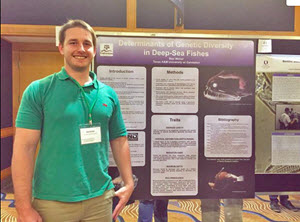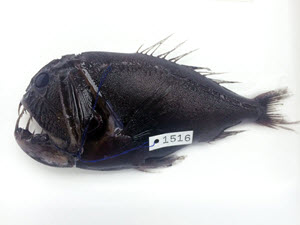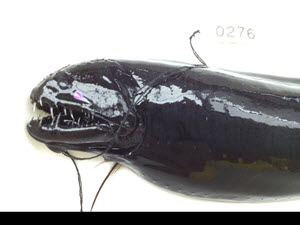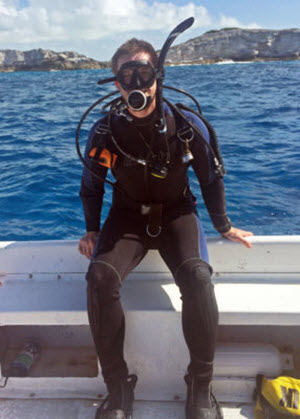
Max removes tissue from a fish for future genetic analysis aboard the RV Point Sur. (Provided by Max Weber)
There are hundreds of deep-pelagic fish species in the Gulf of Mexico, but we know very little about their taxonomy, diversity, and population sizes. Max Weber plans to catch fifteen individual specimens of each of the 500 known deep-sea Gulf fish species to help us better understand these organisms and how the Deepwater Horizon oil spill may have impacted them and environment.
Max is a marine biology master’s student at Texas A&M University (TAMU) and a GoMRI Scholar with the DEEPEND consortium.
His Journey
Max’s desire to become a scientist started with his childhood obsession with dinosaurs, and he told others that he was going to be a paleontologist. “When I got a little older I realized that, while dinosaurs were still amazing, I preferred animals that were not extinct,” Max laughed. His interest turned to marine life and he became, and continues to be, an avid fisherman, motivated by his desire to catch new fish species.
He pursued his scientific interests as an undergraduate at Tulane University where he earned degrees in ecology and evolutionary biology. Prior to pursuing graduate school, he gained real-world experience and skills working with organizations such as San Diego Zoo’s Desert Tortoise Conservation Center and the Houston Audubon Society. The Society’s conservation director Richard Gibbons introduced him to TAMU’s Ron Eytan after discovering Max’s interest in fishery science. “Dr. Eytan offered me a position to work with DEEPEND,” Max said. “This presented a unique opportunity to work with amazing fish from the deep-sea environment that are rarely seen.”
His Work

Max presents his research on deep-sea fish genetic diversity at the 2016 Gulf of Mexico Oil Spill and Ecosystem Science Conference in Tampa, Florida. (Provided by Max Weber)
The remote and extreme physical conditions of the deep-sea environment have inhibited our understanding of deep-sea organisms’ biology and diversity. Scientists have some information about many deep-sea species from a handful of samples, which is rarely enough to understand their taxonomic relationships. Max explained that he is searching for DNA evidence that will help them learn more. “For example, males, females, and juveniles of the family Cetomimidae, usually called whalefishes, are strikingly different and were traditionally classified as three separate families of fish,” Max explained. “DNA evidence finally revealed the true nature of their relationship to one another.”
He and his colleagues collect fish specimens using a Multiple Opening/Closing Net and Environmental Sensing System (MOCNESS), a towed system of multiple automated nets that sample at specific depths. Max identifies the fishes caught, removes some tissue for gene sequencing, and keeps the rest of the fish as a voucher specimen. Back at the lab, he sequences portions of the mitochondrial genome to provide a standard DNA barcode for each sample.
Max explained that this genetic sequencing provides invaluable information and described the project’s first sequences as “a big milestone” and the foundation of his research. His analysis is revealing that a number of species may in fact be cryptic, meaning that they are actually two or three similar species that have been mistakenly classified as the same. He will use the gene sequencing data to investigate patterns of genetic and species diversity and changes in population size over time. This information will help illuminate long-term trends in the Gulf’s deep-sea environment.
His Learning

Anoplogaster cornuta or common fangtooth (Provided by Max Weber).
When beginning his research, Max found himself unexpectedly moved by the contents of the team’s first trawl. “I had seen some of the fish in photos before the cruise, but that was the first time I had encountered any of those rare fish in person,” he said. “As a group, deep-sea fishes are incredible and so different than what you see in other environments.”
He also emphasized the importance of perseverance in scientific research, explaining that lab procedures that have been perfected on common fishes do not always translate well to deep-sea populations. “One thing I am consistently learning is that science may not always go right the first time you try,” he said. “It is critical to have a good attitude and be persistent when your methods require several rounds of adjustment.”
His Future

Echiostoma barbatum (Provided by Max Weber).
Max is considering the possibility of pursuing a Ph.D. and hopes to ultimately find a job in fisheries. “I could go with industry- or university-based fisheries jobs but am leaning towards something in the sphere of a government agency,” he said. Max will complete his fourth research cruise in August and receive another round of sequence data shortly afterwards. He plans to continue analyzing this new data and complete his thesis by spring 2017.
Praise for Max

Max prepares for a dive. (Provided by Max Weber)
Dr. Ron Eytan, assistant professor of marine biology at TAMU Galveston, said that Max impressed everyone with the way he immersed himself in DEEPEND’s team, “Max walked into this project from day one without any background in genetics and took to it wholeheartedly with enthusiasm and confidence.” Eytan said it became apparent on Max’s first research cruise that he would push himself to his mental and physical limits to do what the project needed. “He walked in there; he didn’t get seasick; and he commenced to be on his feet for hours and hours taking genetic samples from fish having never done it before,” Eytan said. “He worked like a champ, and he’s done that every cruise since.”
Max’s work with deep sea species and genetic diversity expands and supports research that Eytan and other DEEPEND scientists are doing with fish genetics overall. “We know nothing about [the species Max investigates] whatsoever,” Eytan said. “His work will make a major contribution to our understanding about how genetic diversity works in the deep sea.”
The GoMRI community embraces bright and dedicated students like Max Weber and their important contributions. The GoMRI Scholars Program recognizes graduate students whose work focuses on GoMRI-funded projects and builds community for the next generation of ocean science professionals. Visit the DEEPEND website to learn more about their work.
************
The Gulf of Mexico Research Initiative (GoMRI) is a 10-year independent research program established to study the effect, and the potential associated impact, of hydrocarbon releases on the environment and public health, as well as to develop improved spill mitigation, oil detection, characterization and remediation technologies. An independent and academic 20-member Research Board makes the funding and research direction decisions to ensure the intellectual quality, effectiveness and academic independence of the GoMRI research. All research data, findings and publications will be made publicly available. The program was established through a $500 million financial commitment from BP. For more information, visit http://gulfresearchinitiative.org/.
